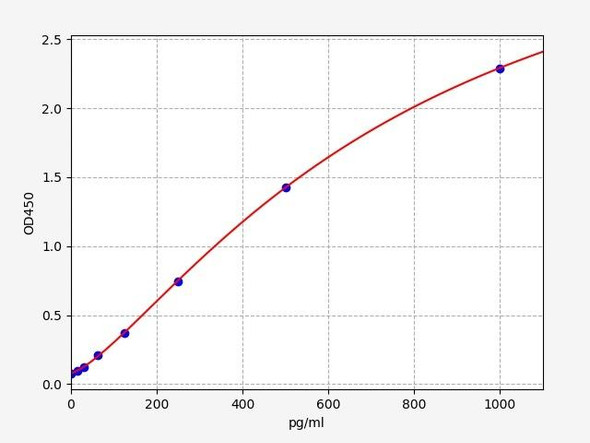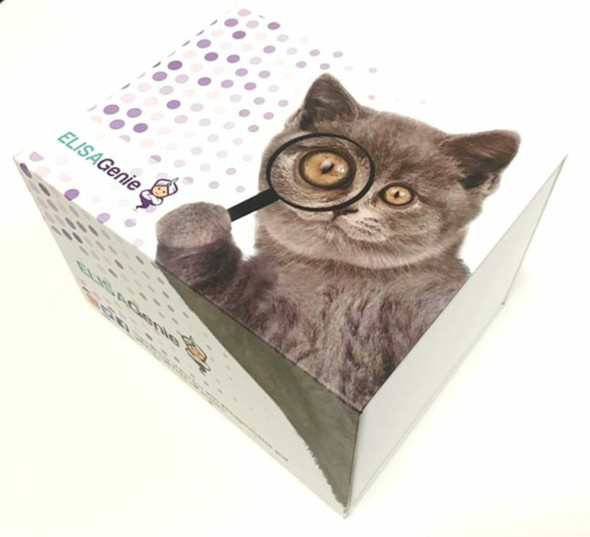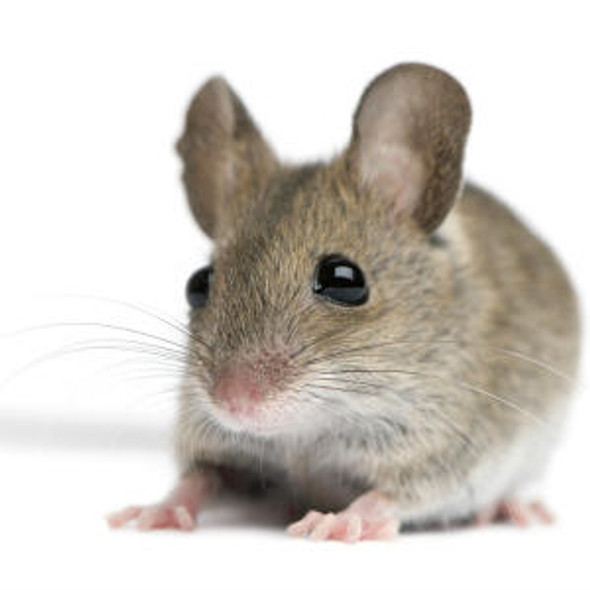Mouse Cell Biology ELISA Kits
Mouse AgRP (Agouti Related Protein) CLIA Kit (MOES00615)
- SKU:
- MOES00615
- Product Type:
- ELISA Kit
- ELISA Type:
- CLIA Kit
- Size:
- 96 Assays
- Sensitivity:
- 4.69pg/mL
- Range:
- 7.81-500pg/mL
- ELISA Type:
- Sandwich
- Synonyms:
- AGRT, ASIP2, ART
- Reactivity:
- Mouse
- Sample Type:
- Serum, plasma and other biological fluids
Description
| Assay type: | Sandwich |
| Format: | 96T |
| Assay time: | 4.5h |
| Reactivity: | Mouse |
| Detection method: | Chemiluminescence |
| Detection range: | 7.81-500 pg/mL |
| Sensitivity: | 4.69 pg/mL |
| Sample volume: | 100µL |
| Sample type: | Serum, plasma and other biological fluids |
| Repeatability: | CV < 15% |
| Specificity: | This kit recognizes Mouse AgRP in samples. No significant cross-reactivity or interference between Mouse AgRP and analogues was observed. |
This kit uses Sandwich-CLIA as the method. The micro CLIA plate provided in this kit has been pre-coated with an antibody specific to Mouse AgRP. Standards or samples are added to the appropriate micro CLIA plate wells and combined with the specific antibody. Then a biotinylated detection antibody specific for Mouse AgRP and Avidin-Horseradish Peroxidase (HRP) conjugate are added to each micro plate well successively and incubated. Free components are washed away. The substrate solution is added to each well. Only those wells that contain Mouse AgRP, biotinylated detection antibody and Avidin-HRP conjugate will appear fluorescence. The Relative light unit (RLU) value is measured spectrophotometrically by the Chemiluminescence immunoassay analyzer. The RLU value is positively associated with the concentration of Mouse AgRP. The concentration of Mouse AgRP in the samples can be calculated by comparing the RLU of the samples to the standard curve.
| UniProt Protein Function: | Function: Plays a role in weight homeostasis. Involved in the control of feeding behavior through the central melanocortin system. Acts as alpha melanocyte-stimulating hormone antagonist by inhibiting cAMP production mediated by stimulation of melanocortin receptors within the hypothalamus and adrenal gland. Has very low activity with MC5R. Is an inverse agonist for MC3R and MC4R being able to suppress their constitutive activity |
| UniProt Protein Details: | By similarity. It promotes MC3R and MC4R endocytosis in an arrestin-dependent manner By similarity. Ref. 4 Subunit structure: Interacts with melanocortin receptors MC3R, MC4R and MC5R. Ref. 4 Subcellular location: Secreted. Golgi apparatus lumen By similarity. Tissue specificity: Expressed in arcuate nucleus and median eminence, adrenal gland (medulla), hypothalamus, testis, and lung. Induction: Hypothalamic expression is elevated circa 10-fold in ob/ob and db/db mice. Domain: The presence of a 'disulfide through disulfide knot' structurally defines this protein as a knottin By similarity. Sequence similarities: Contains 1 agouti domain. |
| NCBI Summary: | This gene encodes a protein that regulates feeding behavior and plays a key role in the control of body weight. The encoded protein acts as an antagonist of melanocortin receptor signaling. Alternatively spliced transcript variants have been observed for this gene. [provided by RefSeq, Nov 2012] |
| UniProt Code: | P56473 |
| NCBI GenInfo Identifier: | 424036681 |
| NCBI Gene ID: | 11604 |
| NCBI Accession: | NP_001258735. 1 |
| UniProt Secondary Accession: | P56473,O35967, |
| UniProt Related Accession: | P56473 |
| Molecular Weight: | 14,432 Da |
| NCBI Full Name: | agouti-related protein |
| NCBI Synonym Full Names: | agouti related protein |
| NCBI Official Symbol: | Agrp |
| NCBI Official Synonym Symbols: | Art; Agrt |
| NCBI Protein Information: | agouti-related protein; orexigenic neuropeptide |
| UniProt Protein Name: | Agouti-related protein |
| Protein Family: | Agouti-related protein |
| UniProt Gene Name: | Agrp |
| UniProt Entry Name: | AGRP_MOUSE |
As the RLU values of the standard curve may vary according to the conditions of the actual assay performance (e. g. operator, pipetting technique, washing technique or temperature effects), the operator should establish a standard curve for each test. Typical standard curve and data is provided below for reference only.
| Concentration (pg/mL) | RLU | Average | Corrected |
| 500 | 50433 52641 | 51537 | 51508 |
| 250 | 19577 22419 | 20998 | 20969 |
| 125 | 9596 9196 | 9396 | 9367 |
| 62.5 | 4457 4567 | 4512 | 4483 |
| 31.25 | 2478 2120 | 2299 | 2270 |
| 15.63 | 1335 1165 | 1250 | 1221 |
| 7.81 | 708 772 | 740 | 711 |
| 0 | 28 30 | 29 | -- |
Precision
Intra-assay Precision (Precision within an assay): 3 samples with low, mid range and high level Mouse AgRP were tested 20 times on one plate, respectively.
Inter-assay Precision (Precision between assays): 3 samples with low, mid range and high level Mouse AgRP were tested on 3 different plates, 20 replicates in each plate.
| Intra-assay Precision | Inter-assay Precision | |||||
| Sample | 1 | 2 | 3 | 1 | 2 | 3 |
| n | 20 | 20 | 20 | 20 | 20 | 20 |
| Mean (pg/mL) | 24.83 | 43.64 | 211.32 | 23.13 | 44.35 | 199.90 |
| Standard deviation | 2.79 | 3.47 | 24.22 | 2.10 | 4.45 | 13.23 |
| C V (%) | 11.24 | 7.95 | 11.46 | 9.08 | 10.03 | 6.62 |
Recovery
The recovery of Mouse AgRP spiked at three different levels in samples throughout the range of the assay was evaluated in various matrices.
| Sample Type | Range (%) | Average Recovery (%) |
| Serum (n=5) | 96-113 | 103 |
| EDTA plasma (n=5) | 101-117 | 108 |
| Cell culture media (n=5) | 91-103 | 96 |
Linearity
Samples were spiked with high concentrations of Mouse AgRP and diluted with Reference Standard & Sample Diluent to produce samples with values within the range of the assay.
| Serum (n=5) | EDTA plasma (n=5) | Cell culture media (n=5) | ||
| 1:2 | Range (%) | 92-107 | 98-116 | 102-117 |
| Average (%) | 100 | 106 | 108 | |
| 1:4 | Range (%) | 97-112 | 91-104 | 103-118 |
| Average (%) | 104 | 96 | 110 | |
| 1:8 | Range (%) | 89-102 | 99-116 | 93-107 |
| Average (%) | 95 | 107 | 99 | |
| 1:16 | Range (%) | 102-116 | 87-98 | 95-108 |
| Average (%) | 108 | 92 | 101 |
An unopened kit can be stored at 4°C for 1 month. If the kit is not used within 1 month, store the items separately according to the following conditions once the kit is received.
| Item | Specifications | Storage |
| Micro CLIA Plate(Dismountable) | 8 wells ×12 strips | -20°C, 6 months |
| Reference Standard | 2 vials | |
| Concentrated Biotinylated Detection Ab (100×) | 1 vial, 120 µL | |
| Concentrated HRP Conjugate (100×) | 1 vial, 120 µL | -20°C(shading light), 6 months |
| Reference Standard & Sample Diluent | 1 vial, 20 mL | 4°C, 6 months |
| Biotinylated Detection Ab Diluent | 1 vial, 14 mL | |
| HRP Conjugate Diluent | 1 vial, 14 mL | |
| Concentrated Wash Buffer (25×) | 1 vial, 30 mL | |
| Substrate Reagent A | 1 vial, 5 mL | 4°C (shading light) |
| Substrate Reagent B | 1 vial, 5 mL | 4°C (shading light) |
| Plate Sealer | 5 pieces | |
| Product Description | 1 copy | |
| Certificate of Analysis | 1 copy |
- Set standard, test sample and control (zero) wells on the pre-coated plate and record theirpositions. It is recommended to measure each standard and sample in duplicate. Note: addall solutions to the bottom of the plate wells while avoiding contact with the well walls. Ensuresolutions do not foam when adding to the wells.
- Aliquot 100µl of standard solutions into the standard wells.
- Add 100µl of Sample / Standard dilution buffer into the control (zero) well.
- Add 100µl of properly diluted sample (serum, plasma, tissue homogenates and otherbiological fluids. ) into test sample wells.
- Cover the plate with the sealer provided in the kit and incubate for 90 min at 37°C.
- Aspirate the liquid from each well, do not wash. Immediately add 100µL of BiotinylatedDetection Ab working solution to each well. Cover the plate with a plate seal and gently mix. Incubate for 1 hour at 37°C.
- Aspirate or decant the solution from the plate and add 350µL of wash buffer to each welland incubate for 1-2 minutes at room temperature. Aspirate the solution from each well andclap the plate on absorbent filter paper to dry. Repeat this process 3 times. Note: a microplatewasher can be used in this step and other wash steps.
- Add 100µL of HRP Conjugate working solution to each well. Cover with a plate seal andincubate for 30 min at 37°C.
- Aspirate or decant the solution from each well. Repeat the wash process for five times asconducted in step 7.
- Add 100µL of Substrate mixture solution to each well. Cover with a new plate seal andincubate for no more than 5 min at 37°C. Protect the plate from light.
- Determine the RLU value of each well immediately.






